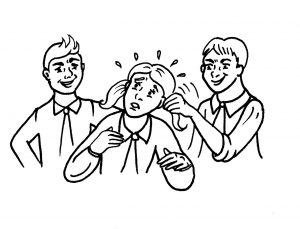
Our society views disease as the enemy and the body as an object to beat into submission. The media has demonized any amount of fat, labeled it as “unhealthy,” and waged war on the “epidemic of obesity.” This has led to stigmatization in the name of “science” and dysfunctional, obsessive, and disordered relationships to our bodies.
Last week (https://www.sizediversityandhealth.org/content.asp?id=161), I discussed the problems with proclaiming war on diseases and the pitfalls of attacking the body. I also explained how an inaccurate portrayal and incomplete review of the science is leading to weight biases as well as the promotion of dieting and restrictive eating patterns for “health.”
I proposed several (unpopular) issues with this approach. Below, I have listed them with additional references:
1. Ethical aspects
- Most weight-centered programs are not practicing health inclusion: rather, they are subject to weight biases and prejudices toward individuals seeking care.
2. Harms associated with a weight-centered vs. a health-inclusive approach
Below are more examples with references on these detrimental effects:
- Body dissatisfaction (1, 2) and “body checking,” which is associated with weight-and-body related shame and guilt
- Nutrient deficiencies from following diets that restrict certain foods
- Disordered eating disguised as “healthy”
- Death (from effects of extreme dieting, anorexia, obesity surgery complications, or from suicide resulting from bullying)
- Mood shifts and emotional highs or lows from calorie restriction or starvation, a/k/a the dual depression hypothesis.
3. Fighting fat is ineffective and not based on conclusive evidence
- Health can be achieved without weight loss as a goal
- Associations with obesity are claimed as “causation” when measurements are not necessarily valid or manipulated, confusing, and not replicated (3, 4, 5)
- Sustained weight loss is rare and does not necessarily result in better health (See additional references at the end of this article – https://www.sizediversityandhealth.org/content.asp?id=161)
I suggested an alternate viewpoint: treating the body with compassion and viewing health as a means to enjoy life, not the goal of life.
Obsession with trying to fit into a societal-induced standard that is unattainable by most has led many people away from enjoying their life to the fullest and diverted attention to their body. Vital brain power now must be devoted to monitoring, tracking, and assessing almost every bodily function (6, 7, 8) in the quest for “fitness” and thinness vs. health.
The Problem Starts Early

Unfortunately, our modern media images of photoshopped “perfection” have trickled down to children. Size awareness and body shaming is now commonplace in elementary schools.
Due to the determinantal effects, the American Academy of Pediatrics (AAP) released a new policy statement regarding weight stigmatization and bullying in youth. According to the article in Pediatrics, the recommendations can be summarized as follows:
In summary, these recommendations include improving the clinical setting by modeling best practices for nonbiased behaviors and language; using empathetic and empowering counseling techniques, such as motivational interviewing, and addressing weight stigma and bullying in the clinic visit; advocating for inclusion of training and education about weight stigma in medical schools, residency programs, and continuing medical education programs; and empowering families to be advocates to address weight stigma in the home environment and school setting.
Medscape provided a wonderful overview summarizing the background and the implications of the AAP statement. Here is an excerpt:
At the core of these recommendations is the fundamental principle of respect for children and families, regardless of their body weight or body size. In a culture where “fat shaming” is commonplace, these guidelines come at a much-needed time as youth continue to be bombarded by messages from the mass media that reinforce shame and blame for having a high body weight.
Pediatricians can help address the harmful impact of weight stigma and create a healthcare environment that emphasizes support, respect, and empowerment at the heart of health behavior change for youth and families affected by obesity.
I’m glad mainstream attention is now focusing on the dangers and health implications of weight bullying that leads to the negative health impacts on our children. (9, 10, 11). For those who want the details of the harm (physical and psychological) done by discrimination, social exclusion, and stigmatization, please see the details in this article and this article.
If only adults and teens were as protected.
In this follow-up article, I review the chronic, unhealthy effects of dieting and caloric restriction. I break down some of the details of the famous starvation experiment that still has implications today. Click here to read it and/or access the full audio version.
Using Essential Oils to Support Emotional Health
In this two-part blog, I discussed a whole children’s line of essential oils that can be used to support our little ones in a holistic way during body shaming incidents. For example, citrus oils can be used for calming and immune support. Synergistic blends of certain oils can aid focus and may assist with self-confidence due to balancing the neurological system.
Essential oils are accessible to everyone. They benefit the body, mind, and spirit, regardless of health status and break the barriers of biases. I have a whole database section on my website focused on emotional support with essential oils.
Disclaimer: This information is applicable ONLY for therapeutic quality essential oils. This information DOES NOT apply to essential oils that have not been tested for purity and standardized constituents. There is no quality control in the United States, and oils labeled as “100% pure” need only to contain 5% of the actual oil. The rest of the bottle can be filled with fillers and sometimes toxic ingredients that can irritate the skin. The studies are not based solely on a specific brand of an essential oil, unless stated. Please read the full study for more information.
This material is for information purposes only and is not intended to diagnose, treat, or prescribe for any illness. You should check with your doctor regarding implementing any new strategies into your wellness regime. These statements have not been evaluated by the FDA. (Affiliation link.)
Images by Pixabay



